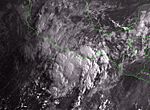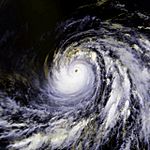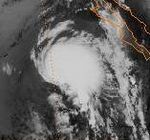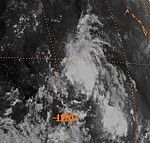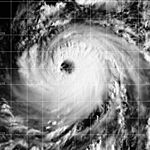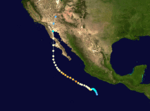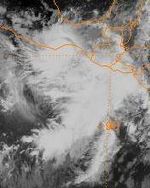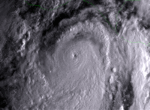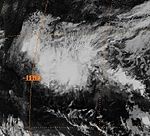1997 Pacific hurricane season facts for kids
 |
|
| Season summary map | |
| First storm formed | June 1, 1997 |
|---|---|
| Last storm dissipated | December 21, 1997 record |
| Strongest storm | Linda 902 mbar (26.64 inHg) – |
| 19 | |
| Total fatalities | 256-426 direct |
| Total damage | $7.6 billion (1997 USD) (record) |
| seasons 1995, 1996, 1997, 1998, 1999 |
|
The 1997 Pacific hurricane season was a time when many strong storms formed in the Pacific Ocean. These storms, called hurricanes and tropical storms, caused a lot of damage and sadly, many people lost their lives. This season had some very powerful storms, including Hurricane Linda, which was one of the strongest ever recorded in the Pacific.
Contents
- Major Storms of the 1997 Season
- Tropical Storm Andres: An Unusual Path
- Tropical Storm Blanca: Short-Lived Threat
- Hurricane Guillermo: A Long-Lasting Giant
- Tropical Storm Ignacio: California's Rare Visitor
- Tropical Storm Oliwa: A Journey Across the Pacific
- Hurricane Linda: A Record-Breaking Storm
- Hurricane Nora: Reaching the United States
- Tropical Storm Olaf: An Erratic Journey
- Hurricane Pauline: The Deadliest Storm
- Hurricane Rick: A Late Season Storm
- Tropical Storm Paka: A December Surprise
- See also
Major Storms of the 1997 Season
Tropical Storm Andres: An Unusual Path
| Tropical storm (SSHS) | |||
|---|---|---|---|
|
|||
| Duration | June 1 – June 7 | ||
| Intensity | 50 mph (85 km/h) (1-min), 998 mbar (hPa) | ||
Tropical Depression One-E started on June 1. The very next day, it grew into Tropical Storm Andres. Andres took a very unusual path, moving towards Central America. This was the first time a storm in the East Pacific had moved like this.
Andres then turned southeast and moved along the coast. It weakened into a tropical depression and made landfall near San Salvador on June 7. The storm then disappeared. Sadly, two fishermen were reported missing because of Andres.
Tropical Storm Blanca: Short-Lived Threat
| Tropical storm (SSHS) | |||
|---|---|---|---|
|
|||
| Duration | June 9 – June 12 | ||
| Intensity | 45 mph (75 km/h) (1-min), 1002 mbar (hPa) | ||
Blanca was a tropical storm that didn't last very long. It briefly looked like it might hit land. Tropical Depression Two-E formed on June 9 and became Tropical Storm Blanca just six hours later.
It moved northwest and briefly threatened the coast on June 10. However, a high-pressure system pushed Blanca away from land. Even though it was over warm water, Blanca unexpectedly started to weaken. It was downgraded to a depression and disappeared on June 12. Luckily, Blanca caused very little damage and no one was hurt.
Hurricane Guillermo: A Long-Lasting Giant
| Category 5 hurricane (SSHS) | |||
|---|---|---|---|
|
|||
| Duration | July 30 – August 15 | ||
| Intensity | 160 mph (260 km/h) (1-min), 919 mbar (hPa) | ||
Hurricane Guillermo started as a tropical wave that moved into the Pacific Ocean on July 27. It became a tropical depression on July 30 and was named Tropical Storm Guillermo the next day. It quickly grew stronger, becoming a hurricane on August 1.
Guillermo became a major hurricane on August 2. It reached Category 4 strength on August 3 and then became a Category 5 hurricane on August 4. At its strongest, Guillermo had winds of 260 km/h (160 mph).
Guillermo then slowly weakened, becoming a tropical storm on August 8. It moved into the Central Pacific. It weakened to a depression on August 10 but became a storm again 24 hours later. It weakened for the last time on August 15 and lost its tropical features. The remnants of Guillermo traveled far north, even reaching near Vancouver Island before finally disappearing on August 24.
Tropical Storm Ignacio: California's Rare Visitor
| Tropical storm (SSHS) | |||
|---|---|---|---|
|
|||
| Duration | August 17 – August 19 | ||
| Intensity | 40 mph (65 km/h) (1-min), 1005 mbar (hPa) | ||
A tropical depression formed on August 17 and became Tropical Storm Ignacio 12 hours later. Ignacio formed further north and west than most storms in this area. It moved north, where it met strong winds and cooler waters. Ignacio lost its tropical features on August 19.
Ignacio brought strong winds to the coast of California before it disappeared. It caused about $50 million in damage. The heavy rain led to power outages and was the worst rain in the area since Hurricane Kathleen in 1976. Ignacio passed directly over the San Francisco Bay Area, where the effects were felt the most.
Tropical Storm Oliwa: A Journey Across the Pacific
| Tropical storm (SSHS) | |||
|---|---|---|---|
|
|||
| Duration | September 2 – September 12 | ||
| Intensity | 40 mph (65 km/h) (1-min), 1004 mbar (hPa) | ||
Tropical Depression Two-C formed on September 2 south of Johnston Atoll. Later that day, it became Tropical Storm Oliwa (which means Oliver in Hawaiian). It slowly moved west and crossed the dateline on September 3.
Oliwa passed south of Wake Island on September 6, bringing heavy rains but no damage. On September 7, Oliwa started to get much stronger, becoming a typhoon on September 8 and a Super Typhoon eight hours later. Oliwa stayed very strong for over two days.
While still a powerful Super Typhoon, Oliwa passed near the Northern Marianas Islands. It then started to weaken as it curved towards Japan. It made landfall as a weak typhoon on September 16 and quickly disappeared. Oliwa caused damage and some people died in Japan.
Hurricane Linda: A Record-Breaking Storm
| Category 5 hurricane (SSHS) | |||
|---|---|---|---|
|
|||
| Duration | September 9 – September 17 | ||
| Intensity | 185 mph (295 km/h) (1-min), 902 mbar (hPa) | ||
A tropical depression formed south of Manzanillo on September 9. It quickly grew stronger, becoming a hurricane early on September 11. It became a major hurricane later that day. Linda continued to get stronger and reached Category 5 intensity the next day.
Linda broke Hurricane Ava's record for strength, which had stood for over 24 years. Linda reached its strongest point on September 12. As of 2005, Linda's intensity record still stands. Linda then started to weaken. On September 15, it was downgraded to a tropical storm. On September 17, it became a depression and disappeared early on September 18.
In California, Linda was linked to 8 deaths and $68 million in damage. Five people drowned near a jetty. Flash floods caused 3 deaths, and mudslides destroyed many homes and caused millions in damage. The Southwest was hit hard again by Hurricane Nora just weeks later.
Hurricane Nora: Reaching the United States
| Category 4 hurricane (SSHS) | |||
|---|---|---|---|
|
|||
| Duration | September 16 – September 26 | ||
| Intensity | 135 mph (215 km/h) (1-min), 950 mbar (hPa) | ||
Hurricane Nora was the first hurricane to pose a big threat to the Continental United States since Hurricane Kathleen in 1976. It started as Tropical Depression 16-E on September 16 and became Tropical Storm Nora the same day. Nora became a hurricane on September 18.
Its movement then slowed, and it weakened over cooler water. On September 20, Nora started moving again and reached its strongest point. On September 21 and September 22, it moved over the path of Hurricane Linda, which weakened it to a Category 1 storm. Nora then turned northeast and headed towards Baja California. After getting a bit stronger, Nora made landfall as a Category 1 hurricane near Punta Eugenia and again south of San Fernando.
Nora remained a tropical storm as it moved into the United States. Yuma reported strong winds. Rains were very heavy, sometimes more than the usual yearly rainfall for the area. Nora weakened to a depression over California and disappeared on September 26.
Nora caused two deaths in Mexico. One person was killed by a downed power line in Mexicali, and another was a scuba diver caught in underwater currents. No one in the United States was directly killed by Nora. However, the California Highway Patrol said that several traffic accident deaths were due to the weather. There was a lot of damage in areas hit by Nora. Waves ruined many homes. About 350 to 400 people lost their homes in San Felipe, and winds pulled up trees and ripped roofs off homes in Puerto Peñasco.
Tropical Storm Olaf: An Erratic Journey
| Tropical storm (SSHS) | |||
|---|---|---|---|
|
|||
| Duration | September 26 – October 12 | ||
| Intensity | 70 mph (110 km/h) (1-min), 989 mbar (hPa) | ||
Olaf was a weak but long-lasting tropical storm that made landfall twice and took a very strange path. A tropical depression formed on September 26, was upgraded to a tropical storm, and immediately moved north. On September 29, Olaf made landfall near Salina Cruz. Olaf then disappeared, and its remnants moved far out to sea.
Olaf's remnants reformed and started moving southeast on October 5. Olaf then turned north, and on October 12, it made a second landfall near Manzanillo. Olaf disappeared again, and its remnants did not reform.
There were a few reports of damage. Three fishing boats went missing near Acapulco, and there was flooding in Mexico and Guatemala. Most of Olaf's damage came from its first landfall.
Hurricane Pauline: The Deadliest Storm
| Category 4 hurricane (SSHS) | |||
|---|---|---|---|
|
|||
| Duration | October 5 – October 10 | ||
| Intensity | 135 mph (215 km/h) (1-min), 948 mbar (hPa) | ||
Hurricane Pauline was the deadliest storm of the season. Landslides and flooding caused by it led to hundreds of people losing their lives.
Tropical Depression Eighteen-E formed on October 5. It briefly moved east before turning northwest. The storm quickly grew stronger, reaching its peak with strong winds and low pressure. It weakened a little before getting strong again.
As Pauline interacted with land, it weakened slightly. The hurricane made landfall on October 9 in an area that wasn't very populated. Moving faster, Pauline traveled along the coast for a day before disappearing on October 10 over Jalisco.
There was no known damage from wind or storm surge. However, heavy rains hit Oaxaca and Guerrero, causing terrible loss of life around Acapulco. Mudslides and flooding were widespread, leaving thousands of people without homes and at least 230 people dead. The Red Cross reported that 400 people had died, but Mexican officials disagreed with this number. Pauline was Mexico's deadliest Pacific hurricane since Hurricane Liza in the 1976 season.
Hurricane Rick: A Late Season Storm
| Category 2 hurricane (SSHS) | |||
|---|---|---|---|
|
|||
| Duration | November 7 – November 10 | ||
| Intensity | 100 mph (155 km/h) (1-min), 973 mbar (hPa) | ||
Hurricane Rick was the first storm to form in November since the 1991 season. A tropical wave became a tropical depression on November 7. It moved north before a low-pressure system turned it northeast. It was named on November 8 and became a hurricane the next day. It reached its strongest point on November 9. Rick made landfall in Oaxaca—the same place hit hard by Hurricane Pauline a month earlier—and quickly weakened, disappearing early on November 11.
No one died because of Rick. Trees were knocked down, and roads that had just been repaired were washed out again.
Tropical Storm Paka: A December Surprise
| Tropical storm (SSHS) | |||
|---|---|---|---|
|
|||
| Duration | December 2 – December 6 | ||
| Intensity | 65 mph (100 km/h) (1-min), 992 mbar (hPa) | ||
Tropical Depression Five-C formed on December 2, two days after the official end of the season. It grew into Tropical Storm Paka (which means Pat in Hawaiian) west of Palmyra Atoll. After drifting east, it changed direction. As it moved west, dry air and strong winds stopped it from getting stronger until it crossed the dateline on December 6.
After entering the Western Pacific, the conditions quickly became better, and Paka started to strengthen rapidly. It became a typhoon on December 10 and passed near Kwajalein with strong winds. It got even stronger, reaching Category 5 intensity twice. While very strong, Paka passed close to Guam on December 17 and December 18, causing "major damage." After that, Paka met harsh conditions and had completely disappeared by the evening of December 21.
See also
 In Spanish: Temporada de huracanes en el Pacífico de 1997 para niños
In Spanish: Temporada de huracanes en el Pacífico de 1997 para niños




